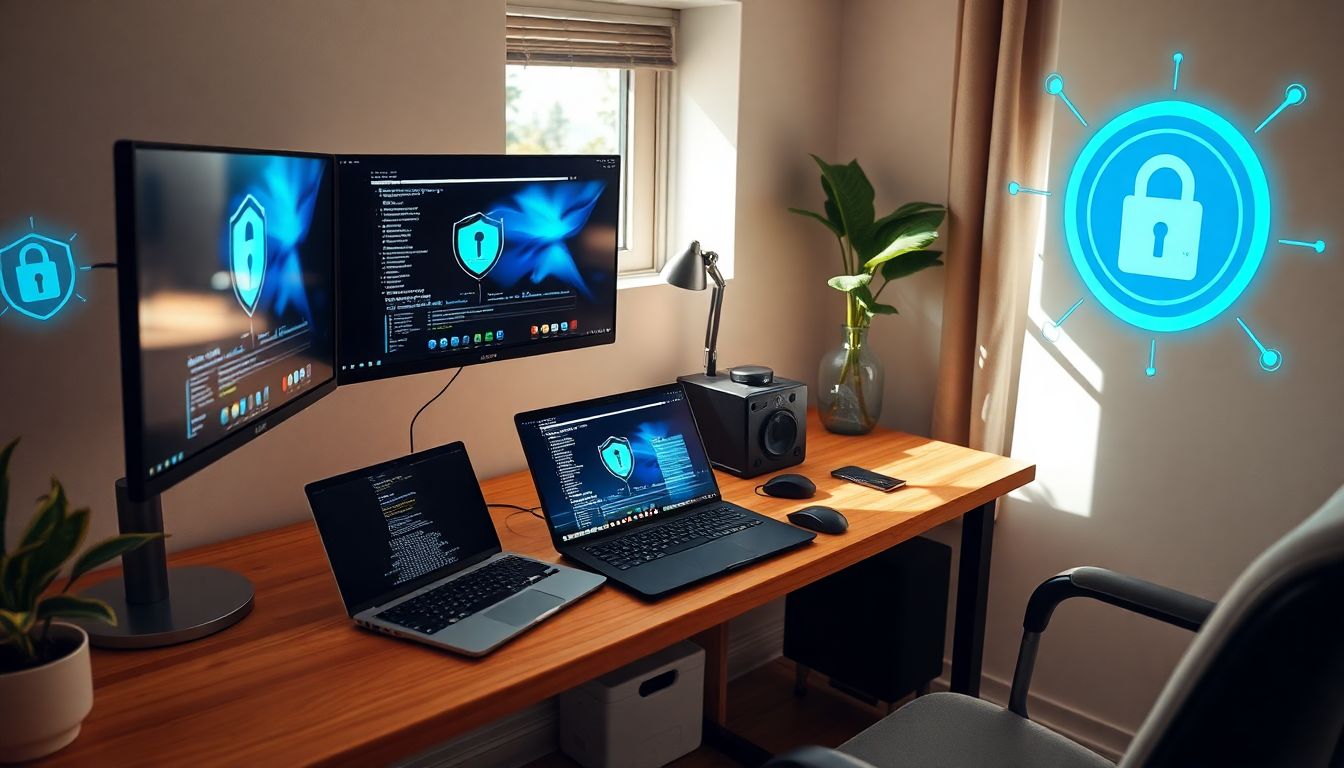Introduction
Remote work has become a part of everyday life for many. It offers more flexibility, saves commute time, and can boost productivity. But with these benefits come new risks. Cyber threats targeting remote workers are rising fast, and they can cause serious damage.
Imagine your sensitive data falling into the wrong hands or your company suffering a costly breach. It’s happening more often than you think. That’s why securing your remote work setup isn’t just smart—it’s essential. Implementing the right tools and habits helps protect your information, keeps your reputation safe, and ensures your work continues smoothly.
Real-world incidents of remote work security breaches show why you need to act now. Don’t wait until it’s too late.
Understanding the Risks of Remote Work Security
The Current Landscape of Remote Work Security Threats
Remote workers face many cyber threats every day. Phishing scams trick you into revealing passwords or clicking harmful links. Malware can sneak in through compromised email attachments or downloads. Weak Wi-Fi connections are another common entry point for cybercriminals.
According to recent cybersecurity reports, remote work-related security incidents have spiked by over 50% in the past year alone. One high-profile breach involved employees accessing company data from insecure devices, leading to a major leak. These incidents show attackers are always looking for new ways to exploit remote setups.
Why Security is Crucial for Remote Work Success
When security fails, it hurts more than just your reputation. Businesses can face hefty fines, legal trouble, and loss of customer trust. Regulatory rules like GDPR or HIPAA demand strict data protection. Ignoring these can lead to serious penalties.
Experts agree that cyber threats are growing more sophisticated. If you aren’t careful, a small mistake today can turn into a big problem tomorrow. Being proactive saves time, money, and stress in the long run.
Essential Tools for Securing Your Remote Work Environment
VPNs (Virtual Private Networks)
A VPN creates a private tunnel for your internet traffic. This encrypts data, making it much harder for hackers to see what you’re doing online. Think of it as a secure private lane for your digital activity.
Choose VPN providers that keep no logs, offer strong encryption, and have reliable speeds. Some popular options include NordVPN and ExpressVPN.
Pro tip: Always connect to a VPN when handling sensitive information—whether it’s company files or personal banking.
Endpoint Security Software
Your laptop or desktop is like your office front door. Antivirus and anti-malware tools guard that door against intruders. They scan files in real-time, block malware, and can even remove infections automatically.
For example, endpoint security prevented ransomware from locking a remote worker’s files last year. It’s like having a security guard watching over your device 24/7.
Secure Collaboration and Communication Tools
Working remotely often means sharing lots of data. Use encrypted messaging apps like Signal or Slack Enterprise. These tools keep your conversations private.
For file sharing, try services like Tresorit or Sync.com. They encrypt your files before upload, adding extra security.
Tip: Always double-check access permissions and avoid sharing sensitive info through unsecured channels.
Password Management Solutions
Strong, unique passwords make hackers’ lives difficult. Using the same password across multiple accounts is a huge risk.
Password managers like LastPass or Dashlane store your passwords securely and can generate new ones automatically. Enable multi-factor authentication (MFA) wherever possible. This adds an extra step, like a code sent to your phone, to verify your identity.
Actionable: Set a reminder to update your passwords every few months. Never leave passwords written down in obvious places.
Network Security Devices
Secure your Wi-Fi with a strong password and WPA3 encryption. If your router is outdated, upgrade it. Modern routers offer better security features and can block unauthorized access.
Using a firewall—either built into your device or via a dedicated hardware device—adds another layer of defense.
Example: Switching to a newer router with built-in security features can make hacking into your network much harder.
Best Practices and Tips for Maintaining Remote Work Security
Physical Security Measures
Keep your devices in a private space where nosy neighbors or family members can’t see or use them. Use privacy screens on your laptop and lock your screen when you step away. Don't leave sensitive papers or drives lying around.
Routine Security Habits
Make software updates a weekly ritual. Patches fix security flaws hackers try to exploit. Stay aware of common phishing tactics—if it sounds too good to be true, it probably is.
Tip: Schedule time every week to check for updates and review your security settings.
Implementing Multi-Factor Authentication (MFA)
MFA adds a second lock on your account. It can be a code sent to your phone or a fingerprint scan. This simple step can stop nearly all hackers from accessing your accounts, even if they get your password.
Data Backup and Recovery Plans
Regular backups save you if hardware fails or ransomware hits. Use cloud services to keep copies of your files off-site. Test your backups periodically to make sure you can restore data quickly after an attack.
Establishing Remote Work Policies
Set clear rules for device use, data sharing, and security steps. Educate everyone on safe practices. Companies that enforce strong policies see fewer security incidents.
Example: A firm reduced breaches by creating simple, straightforward rules for onboarding new remote employees and providing quick security training.
Conclusion
Securing your remote work setup isn’t just about one tool or a single habit. It’s a combination of the right software, smart practices, and ongoing awareness. Protecting your data and devices keeps your work safe and your reputation intact.
Today’s security measures can prevent costly breaches tomorrow. Take action by implementing these tools and tips now. Your future self—and your company—will thank you.
Start with small steps. Before you know it, you’ll work confidently knowing your remote setup is secure. Stay safe, stay productive.
